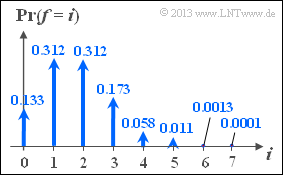Exercise 2.15Z: Block Error Probability once more
From LNTwww
Using a Reed–Solomon code with the correctability t and "Bounded Distance Decoding" (BDD) is obtained for the block error probability with
- the code word length n and
- the symbol falsification probability εS:
- Pr(blockerror)=n∑f=t+1(nf)⋅εSf⋅(1−εS)n−f.
In this exercise, the block error probability for the RSC(7,3,5)8 and various εS values shall be calculated and approximated.
- The above equation is reminiscent of the "Biomial Distribution".
- The graph shows the probabilities of the binomial distribution for parameters n=7 ("code word length") and εS=0.25 ("symbol falsification probability").
Hints:
- This exercise belongs to the chapter "Error Probability and Application Areas".
- For checking, you can use the interactive HTML5/JavaScript applet "Binomial and Poisson Distribution".
Questions
Solution
(1) For the RSC(7,3,5)8, because dmin=5 ⇒ t=2 gives the block error probability:
- Pr(blockerror) = 7∑f=3(7f)⋅εSf⋅(1−εS)7−f
- ⇒Pr(blockerror)=(73)⋅0.13⋅0.94+(74)⋅0.14⋅0.93+(75)⋅0.15⋅0.92+(76)⋅0.16⋅0.9+(77)⋅0.17.
- According to this calculation, five terms would have to be considered. However, since
- Pr(blockerror)=n∑f=0(nf)⋅εSf⋅(1−εS)n−f=1
- is also valid, the following calculation is faster:
- Pr(blockerror)=1−[(70)⋅0.97+(71)⋅0.1⋅0.96+(72)⋅0.12⋅0.95]=1−[0.4783+0.3720+0.1240]=2.57⋅10−2_.
(2) Analogous to the subtask (1) one obtains here:
- Pr(blockerror) = 1−[0.997+7⋅0.01⋅0.996+21⋅0.012⋅0.995]=1−[0.9321+0.0659+0.0020]≈0.
- This means: For the probability εS=0.01 the simplified calculation is very error-prone, because a value close to 1 results for the bracket expression.
- The full calculation yields here:
- Pr(blockerror) = (73)⋅0.013⋅0.994+(74)⋅0.014⋅0.993+(75)⋅0.015⋅0.992+(76)⋅0.016⋅0.99+(77)⋅0.017
- ⇒Pr(blockerror)=10−6⋅[33.6209+0.3396+0.0021+...]≈3.396⋅10−5_.
(3) From the sample solution to the subtask (2) the result can be read directly:
- Pr(blockerror)≈3.362⋅10−5_.
- The relative error is about −1%.
- The minus sign indicates that this is only an approximation and not a bound: The approximate value is slightly smaller than the actual value.
(4) Restricting to the relevant term (f=3), we get εS=0.001:
- Pr(blockerror)≈(73)⋅[10−3]3⋅0.9994≈3.49⋅10−8_.
- The relative error here is only about −0.1%.
(5) According to the derived approximation, the following holds for the considered code:
- Pr(blockerror)≈(73)⋅εS3=35⋅εS3⇒Pr(blockerror)=10−10:εS=(10−1035)1/3=2.8571/3⋅10−4≈1.42⋅10−4_.
